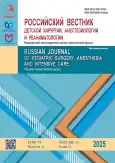Хирургическое лечение детей с нейрофиброматозом 1-го типа: серия случаев
- Авторы: Суходольская О.В.1, Дорофеева М.Ю.2, Боченков С.В.2, Пивоварова А.М.2, Забродина А.Р.2, Дживанширян Г.В.2, Тарасова Д.С.1, Айрапетян М.И.1,2, Морозов Д.А.1,2
-
Учреждения:
- Первый Московский государственный медицинский университет им. И.М. Сеченова
- Российский национальный исследовательский медицинский университет им. Н.И. Пирогова
- Выпуск: Том 15, № 2 (2025)
- Страницы: 181-192
- Раздел: Оригинальные исследования
- URL: https://journal-vniispk.ru/2219-4061/article/view/313000
- DOI: https://doi.org/10.17816/psaic1844
- EDN: https://elibrary.ru/TSLHBO
- ID: 313000
Цитировать
Полный текст
Аннотация
Обоснование. Среди наследственных заболеваний, предопределяющих возникновение в организме человека опухолей, нейрофиброматоз 1-го типа занимает лидирующее место. Из-за гетерогенности клинических симптомов, характерных для данного заболевания, пациенты обращаются к разным специалистам, что объективно приводит к недооценке симптомов и несвоевременной диагностике заболевания.
Цель — учитывая редкость патологии и отсутствие до настоящего времени в нашей стране единых протоколов ведения пациентов с нейрофиброматозом 1-го типа, провести сравнительный анализ диагностики и хирургического лечения пациентов с этим заболеванием.
Материалы и методы. Ретроспективно проанализированы клинические данные 20 детей, которым было проведено хирургическое лечение по поводу нейрофиброматоза 1-го типа, наблюдавшихся в Научно-исследовательском клиническом институте педиатрии и детской хирургии им. акад. Ю.Е. Вельтищева.
Результаты. Было изучено 20 историй болезни (9 мальчиков и 11 девочек). Медиана возраста постановки диагноза составила 7 лет (1–17 лет). У большинства пациентов (n = 15) проявления нейрофиброматоза 1-го типа затрагивали область головы/шеи. Обращено внимание на отсутствие единого протокола исследования детей с подозрением на нейрофиброматоз: 19 пациентам выполнена магнитно-резонансная томография пораженной области, а магнитно-резонансная томография головного мозга и ультразвуковое исследование органов брюшной полости были выполнены только у трети пациентов. Всего было проведено 36 операций. Показанием к оперативному лечению в 20 случаях стало наличие объемного образования. У 3 пациентов с нейрофибромами первичное гистологическое заключение было ошибочным, что привело к несвоевременной постановке диагноза и неправильной тактике. Рецидивы роста опухолей были отмечены в 14 из 26 случаев полного их удаления, что потребовало выполнения повторных оперативных вмешательств (n = 9). В статье представлено редкое клиническое наблюдение ганглионейрофиброматоза кишечника.
Заключение. Вариабельность клинических проявлений и редкость патологии, отсутствие настороженности детских хирургов в отношении данного заболевания зачастую приводили к несвоевременной диагностике и некорректному лечению. Дети наблюдались и обследовались у разных специалистов без системного подхода, часто получая хирургическое лечение без учета особенностей патогенеза их заболевания. Важным является создание клинического реестра таких пациентов, а также мультидисциплинарных команд врачей, принятие решения о выборе тактики лечения детей с нейрофиброматозом 1-го типа исключительно посредством консилиума.
Полный текст
Открыть статью на сайте журналаОб авторах
Ольга Владимировна Суходольская
Первый Московский государственный медицинский университет им. И.М. Сеченова
Автор, ответственный за переписку.
Email: betti_olga99@mail.ru
ORCID iD: 0000-0002-8868-4763
SPIN-код: 2881-3415
Россия, Москва
Марина Юрьевна Дорофеева
Российский национальный исследовательский медицинский университет им. Н.И. Пирогова
Email: mdorofeeva@inbox.ru
ORCID iD: 0000-0001-7879-315X
SPIN-код: 5156-1745
канд. мед. наук
Россия, МоскваСергей Викторович Боченков
Российский национальный исследовательский медицинский университет им. Н.И. Пирогова
Email: boch@pedklin.ru
ORCID iD: 0000-0002-7291-5459
SPIN-код: 6584-4201
Россия, Москва
Александра Михайловна Пивоварова
Российский национальный исследовательский медицинский университет им. Н.И. Пирогова
Email: ampivovarova@gmail.com
ORCID iD: 0000-0002-7520-1072
SPIN-код: 2754-6879
канд. мед. наук
Россия, МоскваАнна Романовна Забродина
Российский национальный исследовательский медицинский университет им. Н.И. Пирогова
Email: zabrodina@pedklin.ru
ORCID iD: 0000-0003-4816-9369
SPIN-код: 8382-4911
Россия, Москва
Гоар Владимировна Дживанширян
Российский национальный исследовательский медицинский университет им. Н.И. Пирогова
Email: Dzhivanshiryan.g@pedklin.ru
ORCID iD: 0000-0002-1105-9679
Россия, Москва
Дарья Сергеевна Тарасова
Первый Московский государственный медицинский университет им. И.М. Сеченова
Email: dtarasowa@yandex.ru
ORCID iD: 0000-0003-2387-8740
SPIN-код: 2175-3280
канд. мед. наук
Россия, МоскваМаксим Игоревич Айрапетян
Первый Московский государственный медицинский университет им. И.М. Сеченова; Российский национальный исследовательский медицинский университет им. Н.И. Пирогова
Email: Drairmaxim@gmail.com
ORCID iD: 0000-0002-0348-929X
SPIN-код: 3683-7312
канд. мед. наук, доцент
Россия, Москва; МоскваДмитрий Анатольевич Морозов
Первый Московский государственный медицинский университет им. И.М. Сеченова; Российский национальный исследовательский медицинский университет им. Н.И. Пирогова
Email: damorozov@list.ru
ORCID iD: 0000-0002-1940-1395
SPIN-код: 8779-8960
д-р мед. наук, профессор
Россия, Москва; МоскваСписок литературы
- Farschtschi S, Mautner V-F, Cecilia Lawson McLean A, et al. The neurofibromatoses. Dtsch Arztebl Int. 2020;117:354–360. doi: 10.3238/arztebl.2020.0354
- Garozzo D. Peripheral nerve tumors in neurofibromatosis 1: An overview on management and indications for surgical treatment in our experience. Neurology India. 2019;67(S1):S38–S44. doi: 10.4103/0028-3886.250697
- Dogra BB, Rana KS. Facial plexiform neurofibromatosis: A surgical challenge. Indian Dermatol Online J. 2013;4(3):195–198. doi: 10.4103/2229-5178.115515
- Resolution of the Expert council on the problems of diagnosis and treatment of patients with plexiform neurofibromas. Russian Journal of Pediatric Hematology and Oncology. 2021;8(2):144–152. doi: 10.21682/2311-1267-2021-8-2-144-152 EDN: FAFYHA
- Blakeley JO, Plotkin SR. Therapeutic advances for the tumors associated with neurofibromatosis type 1, type 2, and schwannomatosis. Neuro Oncol. 2016;18(5):624–638. doi: 10.1093/neuonc/nov200
- Prudner BC, Ball T, Rathore R, Hirbe AC. Diagnosis and management of malignant peripheral nerve sheath tumors: Current practice and future perspectives. Neurooncol Adv. 2020;2(S1):i40–i49. doi: 10.1093/noajnl/vdz047
- Hirbe AC, Gutmann DH. Neurofibromatosis type 1: a multidisciplinary approach to care. Lancet Neurol. 2014;13(8):834–843. doi: 10.1016/S1474-4422(14)70063-8
- Legius E, Messiaen L, Wolkenstein P, et al. Revised diagnostic criteria for neurofibromatosis type 1 and Legius syndrome: an international consensus recommendation. Genet Med. 2021;23(8):1506–1513. doi: 10.1038/s41436-021-01170-5
- Bergqvist C, Servy A, Valeyrie-Allanore L, et al. Neurofibromatosis 1 French national guidelines based on an extensive literature review since 1966. Orphanet J Rare Dis. 2020;15(1):37. doi: 10.1186/s13023-020-1310-3
- Mauro A, Zenzeri L, Esposito F, et al. Isolated intestinal Ganglioneuromatosis: case report and literature review. Ital J Pediatr. 2021;47(1):80. doi: 10.1186/s13052-021-01024-5
- Rabab’h O, Gharaibeh A, Al-Ramadan A, Ismail M, Shah J. Pharmacological approaches in neurofibromatosis type 1-associated nervous system tumors. Cancers. 2021;13(15):3880. doi: 10.3390/cancers13153880
- Bai R-Y, Esposito D, Tam AJ, et al. Feasibility of using NF1-GRD and AAV for gene replacement therapy in NF1-associated tumors. Gene Ther. 2019;26(6):277–286. doi: 10.1038/s41434-019-0080-9
- Gross AM, Wolters PL, Dombi E, et al. Selumetinib in children with inoperable plexiform neurofibromas. N Engl J Med. 2020;382(15):1430–1442. doi: 10.1056/NEJMoa1912735
- Hsieh DT, Rohena LO, Talaver F, et al. Neurofibromatosis type 1 differential diagnoses. Medscape, 2022.
- Gerszten PC, Burton SA, Ozhasoglu C, et al. Radiosurgery for benign intradural spinal tumors. Neurosurgery. 2008;62(4):887–895. doi: 10.1227/01.neu.0000318174.28461.fc
- Friedrich RE, Schmelzle R, Hartmann M, et al. Resection of small plexiform neurofibromas in neurofibromatosis type 1 children. World J Surg Oncol. 2005;3(1):6. doi: 10.1186/1477-7819-3-6
Дополнительные файлы








